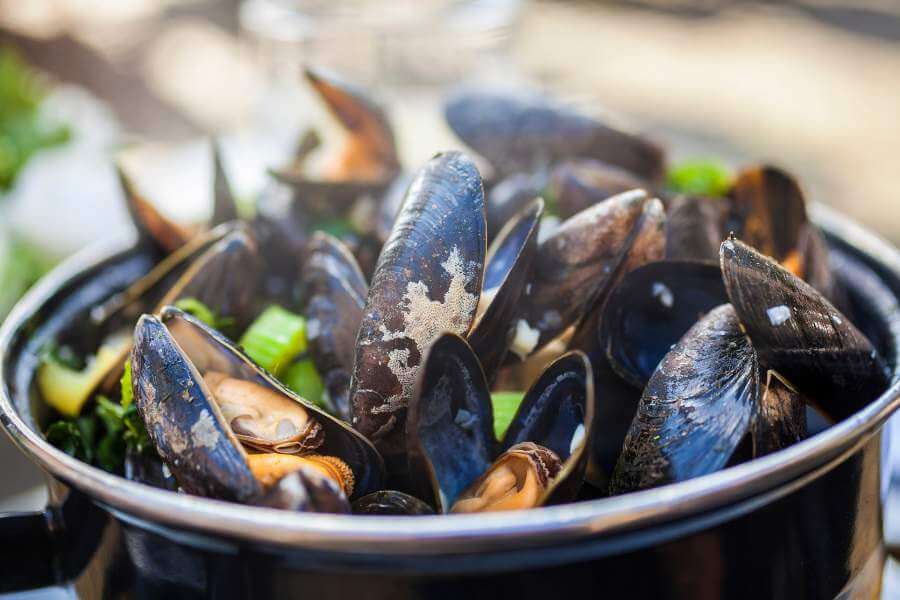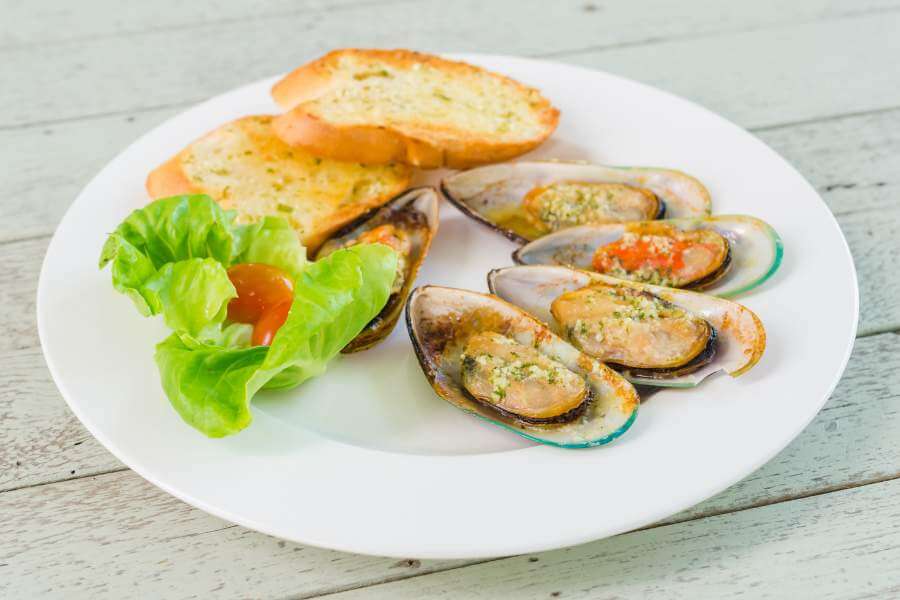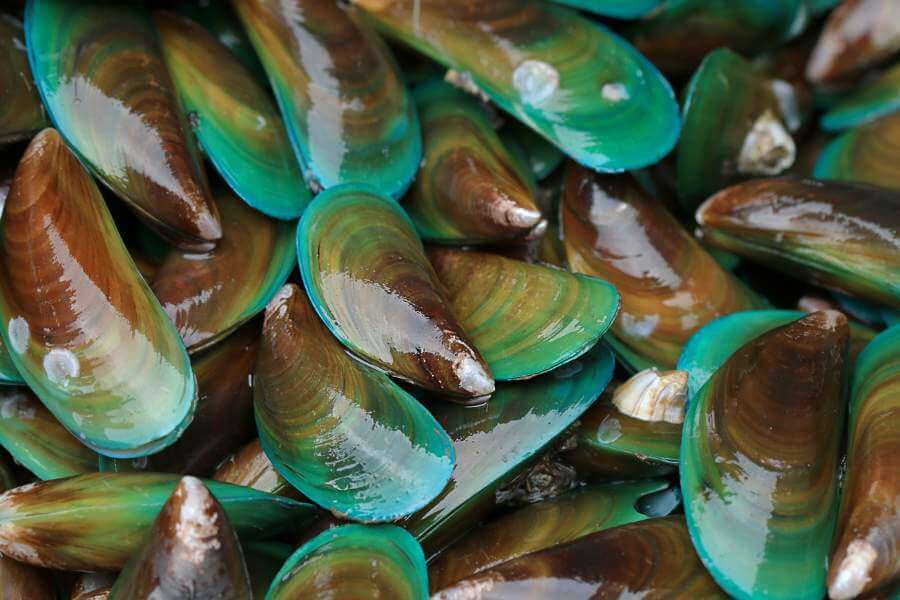Green Mussels vs Blue Mussels: When it comes to mussels, you may have noticed that there are different colors available. Specifically, green mussels and blue mussels are two popular options. But what exactly is the difference between them?
Green mussels (Perna viridis) and blue mussels (Mytilus edulis) are both popular types of mussels consumed worldwide, but they have some differences in terms of taste, habitat, and availability.
In this blog post, I will delve into the world of mussels and compare the characteristics of green mussels and blue mussels. From their taste and texture to their nutritional profiles, we’ll explore everything you need to know about these tasty mollusks.
So whether you’re a seafood lover or just curious about the different types of mussels, keep reading to discover the unique qualities of green and blue mussels.
Table of Contents
What Are Mussels?
Mussels are bivalve mollusks commonly found in freshwater and saltwater environments. They have a soft, fleshy body enclosed in a hard, hinged shell. With a two-part hinged shell, they extract nutrients from the water as filter feeders. These delicacies come in various colors like green, blue, black, and brown and are known for their tender meat and rich flavor.
Mussels are bivalve mollusks belonging to the family Mytilidae. They are found in both freshwater and marine environments worldwide, inhabiting coastal areas, estuaries, and sometimes even deep-sea habitats. Mussels have two hinged shells connected by a strong, flexible ligament. They are filter feeders, meaning they draw in water to filter out plankton and other organic matter for food.
Mussels are commonly harvested for human consumption due to their delicious taste and nutritional value. They are a good source of protein, omega-3 fatty acids, vitamins (such as B12), and minerals (such as iron and selenium). They are often prepared in various dishes, including soups, stews, pastas, and as a standalone appetizer, typically steamed or boiled.
Origin and Habitat of Green Mussels and Blue Mussels

Green mussels, scientifically known as Perna viridis, are commonly found in the Indo-Pacific region. These mussels thrive in warm waters and are known for their vibrant green color. On the other hand, blue mussels, or Mytilus edulis, can be found in the North Atlantic and North Pacific oceans. Blue mussels thrive in cooler temperate regions.
Both species attach themselves to rocks, piers, and other hard surfaces using byssal threads, but green mussels can also be found in muddy substrates. Green mussels are known for their fast growth rate, reaching maturity in just 6 to 9 months, while blue mussels take around 2 years to reach reproductive age. Crabs are known to be one of the main predators of mussels, and their presence can greatly impact the population of these bivalves.
Blue mussels have a higher tolerance for low salinity levels than green mussels, allowing them to survive in estuaries and brackish waters.
On average, they are approximately 4-5 inches long, and both are nearly identical in size.
Exploring the Differences: Green Mussels vs Blue Mussels
1. Green Mussels vs Blue Mussels: Shell and Appearance

There are several noticeable differences when comparing the shell and appearance of green and blue mussels. Green mussels have a smooth, shiny, dark green shell, while blue mussels have a rougher, bluish-black shell.
Additionally, the shell of green mussels is typically larger and more elongated than blue mussels’ rounder shape. Both mussels use a byssal thread to attach themselves to surfaces, but the color differs – green for green mussels and brown for blue mussels.
Green mussels often have lighter-colored edges on their shells, while blue mussels have more uniform coloration. The shell’s interior also differs in color, with green mussels having a bright green hue and blue mussels having a pearly white or pale yellow color.
2. Green Mussels vs Blue Mussels: Taste and Culinary Uses

Green mussels and blue mussels have distinct characteristics. Green mussels have a firmer texture, making them ideal for grilling or baking. On the other hand, blue mussels are more tender and delicate, perfect for steaming or adding to pasta dishes with a tender texture.
Green mussels have a slightly sweet and rich flavor with a hint of saltiness and flavor compared to the delicate oceanic flavor of blue mussels.
However, both types of mussels are versatile and can be used interchangeably in various seafood recipes, allowing seafood lovers to enjoy their favorite dishes with either type of mussels.
3. Nutritional Value: Green Mussels vs Blue Mussels

When it comes to nutritional value, green mussels and blue mussels have their unique offerings. Green mussels are rich in protein and omega-3 fatty acids, making them a great choice for seafood lovers looking to boost their intake of this essential nutrient.
On the other hand, blue mussels have a higher iron content, making them an excellent source of this essential mineral. Additionally, green mussels are known for their higher vitamin B12 and selenium levels, while blue mussels provide a slightly higher calcium content.
Both types of mussels can be a nutritious addition to your diet, providing you with essential nutrients and promoting overall health and well-being.
4. Sustainability and Environmental Impact

Several factors come into play when considering the sustainability and environmental impact of green mussels vs blue mussels. Green mussels are filter feeders, meaning they extract nutrients from the water by filtering it through their bodies. This process helps to improve water quality by removing excess nutrients and reducing the risk of harmful algal blooms.
Additionally, green mussels can be grown using sustainable aquaculture practices, which minimize negative impacts on marine ecosystems.
On the other hand, blue mussels can also help mitigate climate change’s effects. They sequester carbon dioxide from the atmosphere and store it in their shells and tissues, effectively acting as a carbon sink.
Furthermore, blue mussel farming is a sustainable practice that requires minimal resources and has low environmental impacts compared to other forms of aquaculture.
Overall, both types of mussels can be helpful for sustainability and environmental impact.
5. Cooking Methods and Recipes: Green Mussels vs Blue Mussels

These mouthwatering recipes highlight the versatility of mussels, allowing you to explore a variety of global flavors with this delectable shellfish as the star ingredient. Whether you’re a seafood lover or looking to expand your culinary horizons, these dishes will impress.
Thai Green Mussel Curry (Thai Cuisine):
Enjoy the vibrant flavors of Thailand with this aromatic Green Mussel Curry. Simmer succulent green mussels in a coconut milk-based sauce infused with lemongrass, kaffir lime leaves, and Thai green curry paste. Serve over steamed jasmine rice for an authentic Thai dining experience.
Green Mussel Tapas (Spanish Cuisine):
Embrace the Spanish tapas culture with Green Mussel Tapas. Top freshly steamed green mussels with a zesty mixture of garlic, parsley, and breadcrumbs, and then lightly broil them until golden brown. Squeeze fresh lemon juice over the mussels before serving for a burst of flavor.
Green Mussel Stir-Fry (Asian Fusion Cuisine):
Embark on an Asian fusion culinary adventure with a Green Mussel Stir-Fry. Sauté green mussels with colorful bell peppers, snow peas, and broccoli in a savory soy-ginger sauce. This quick and flavorful dish pairs beautifully with steamed jasmine rice or noodles.
Blue Mussel Linguine (Italian Cuisine):
Transport yourself to Italy with this delightful Blue Mussel Linguine dish. Toss al dente linguine with a garlic-infused white wine sauce and freshly steamed blue mussels. Garnish with parsley and a sprinkle of grated Parmesan cheese for a satisfying Italian-inspired meal.
Blue Mussel and Coconut Curry (Indian Cuisine):
Indulge in the aromatic spices of India with this Blue Mussel and Coconut Curry. Simmer blue mussels in a rich coconut milk-based sauce infused with curry spices, ginger, and garlic. Serve with fluffy basmati rice or warm naan bread for a hearty and flavorful experience.
Blue Mussel Chowder (American Cuisine):
Enjoy the comforts of American cuisine with a hearty and creamy Blue Mussel Chowder. Combine blue mussels with potatoes, onions, celery, and bacon in a velvety broth with clam juice and heavy cream. Serve piping hot with crusty bread for a satisfying meal.
6. Availability and Farming

Green Mussels and Blue Mussels tend to thrive in different regions, catering to various culinary markets. Green Mussels predominantly flourish in warmer tropical waters, commonly found in the coastal regions of Asia, Australia, and New Zealand. Their preference for these climates makes them a popular choice in Asian cuisine.
On the other hand, Blue Mussels prefer cooler waters and are typically found in the North Atlantic and Pacific Oceans. Due to their widespread distribution and adaptability to different environments, Blue Mussels are more commonly harvested and available worldwide.
In terms of farming, both mussel varieties are cultivated to meet the growing demand for sustainable seafood. Green Mussels are often farmed in specialized aquaculture systems, suspended on ropes or nets in shallow waters, allowing them to filter-feed and grow in nutrient-rich environments.
This farming method promotes their natural growth and helps maintain ecological balance in the surrounding waters. Similarly, Blue Mussels are farmed using similar methods, making them a popular choice for aquaculture due to their rapid growth rate and ability to convert nutrients into protein efficiently.
FAQs to Green Mussels vs Blue Mussels
How Many Costs of Green and Blue Mussels?
Green mussels tend to be pricier and less readily available than blue mussels. While blue mussels can be found in supermarkets and seafood markets at affordable prices, the cost of green mussels is higher due to limited supply and higher demand. Availability may also vary depending on the region and season.
Which type of mussel is commonly available in seafood markets?
Blue mussels are commonly found in grocery stores and seafood markets, while green mussels (New Zealand mussels) may be less readily available. Availability can vary based on location and season, with blue mussels often being locally harvested, making them more accessible in certain regions.
Which country has the best mussels?
Belgium, France, New Zealand, and Canada are renowned for their high-quality mussels. However, Belgian mussels are known for their large size and rich flavor, while New Zealand mussels are praised for their sweet taste and plump texture.
Why Won’t My Mussels Open after Cooking?
If your mussels don’t open after cooking, they may be dead and should not be consumed. Overcooking can also make them tough to open. Clean and debeard them properly before cooking to ensure they open well. Discard any mussels that remain closed to avoid the risk of foodborne illness.
Which is better blue or green mussels?
Both blue mussels (Mytilus edulis) and green mussels (Perna viridis) are popular choices for consumption, each offering distinct flavors and textures. The preference between the two largely depends on personal taste. Blue mussels typically have a slightly sweeter and milder flavor compared to green mussels, which tend to have a more robust and briny taste.
What are the best kind of mussels to eat?
As for the best kind of mussels to eat, it ultimately comes down to individual preference. Some people prefer the taste and texture of blue mussels, while others enjoy the stronger flavor of green mussels. Both types can be delicious when prepared properly.
Are green mussels safe to eat?
Green mussels are safe to eat when harvested from clean waters and handled and cooked correctly. However, like any seafood, it’s essential to ensure that they come from reputable sources and are fresh.
Is it OK to eat mussels every day?
Regarding eating mussels every day, it’s generally safe to consume them in moderation as part of a balanced diet. Mussels are an excellent source of protein, omega-3 fatty acids, vitamins, and minerals.
However, it’s essential to vary your diet to ensure you’re getting a wide range of nutrients and to avoid potential issues with heavy metal accumulation, which can occur with frequent consumption of certain types of seafood. As always, consulting with a healthcare professional or nutritionist for personalized dietary advice is recommended.
Final Words
In conclusion, green and blue mussels have unique characteristics and culinary uses. However, both types of mussels are highly nutritious, packed with vitamins.
Ultimately, the choice between green and blue mussels depends on preference and availability. Whether you’re a chef experimenting with different flavors or a seafood lover looking to try something new, green mussels offer a delicious and healthy addition to your meals.
So why not try them and tell us your favorite in the comments below?

